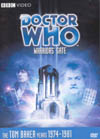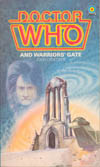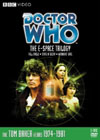DVD Extras include:
The Excellent Concept with the Missing Mechanism
Understanding this ability of the Tharrils is key to understanding Biroc's motivation, and thus most of the advice he spouts throughout the story. He sees how events may unfold near the beginning of the story. And because this page is for those who have not seen how events unfold yet, I will save the rest of my dissection of this story's philosophy and plot mechanics for the In-depth Analysis version of this review. Suffice it to say that there are huge flaws in both that have dragged this story's reputation down with most fans, while some others revere it as being too sophisticated for television. Perhaps just too inarticulate for television in my view. It is important here too, to note the dominant viewpoint coming through in the dialogue. Rorvik and his crew get most of the lines, and what is perhaps even more important, their lines are the most easily understood, so that deeply colours the way the audience will tend to see the situation. Had Gallagher's story included a certain key element, it could have both provided what I feel is a more accurate understanding of what allows a choice to lead to an alternate timeline, and made a damn finer tapestry of satisfying story beats. Ultimately I think Gallagher's philosophy itself is lacking this key.
Cinema Divorced from StoryMoving on to investigate the cinematic qualities of this adventure, it is easy to see how further easy points for clarity of story-telling were lost. A very nice atmospheric tour of the empty sections of Rorvik's ship opens the story - but what really is the point? Building up mystery in the minds of the audience as to where the story is taking place? The instant that the techno-babble begins between the crewmembers on the bridge, such mystery is sorely out of place. What was needed was an establishing shot of the ship, showing what kind of bizarre environment it was in, to help the audience make sense both of what was going on, and of what later gets said. Even worse, no establishing shot of the ship appears anywhere in the first episode. We have to wait until episode two - nice, but ridiculously late to be visually literate.And what environment is the ship in? According to the novelization, a space battle only just puts the ship into the white void before the events on screen begin, but on TV, we get a line about being "stuck in this nothing for months and months, and now this..." Which is it? Does it matter? The TARDIS too could do with an establishing shot - one of the real police box so that the rotating wire-mesh representations on the Privateer's computer screens might make sense to someone who'd never seen the show before. As it stands, the first episode is a disaster of obvious missing shots, which leaves a heck of a lot to be desired. The satisfying materialization of the police box is also nowhere on the menu today. In the end this just isn't a good story to introduce people to the world of Doctor Who, and at minimum should only be seen after viewing the two preceding instalments of the E-space Trilogy. The story also boasts frenetic, overly confusing editing, as particularly evidenced by anyone who starts watching episode three cold. This portion of the story is full of so many extremely short scenes of various characters in various places doing not-so-obvious things, it would no doubt completely boggle the mind of any casual viewer. This section desperately needs to stay attached to the rest of the story to make sense, as in a movie compilation. Episodically, it's a disaster. Things become a little clearer, spatially, as episode three progresses, but just count the number of half-scenes and half-conversations that the story cuts between during this section, most of which make no real point or have any emotional impact. If the director could stick with something, anything, and follow it through and make it worthy of a longer attention span, the tale would be much, much better off. To top it all off, note that in the midst of this bizarrely edited episode, we get the definitive establishing shot of the entire story, panning across the void to show everything, backed by the story's definitive musical phrase no less. Great! But why here in episode three? Why right here when, at this point, no characters are drawing any attention to the geography? It boggles the mind.
Redeeming Elements
I like the Gundan robots - I think they add much to the mysterious menacing atmosphere, both by their twisted vocalization of essential exposition, and with most of their shorter action scenes. Sadly, some early Gundan action could have been so much more polished with a few additional takes; I sense the relentless studio clock taking its toll on a Doctor Who production yet again. Clifford Rose turns in a top-notch performance as the hard-hitting, tightly coiled Captain Rorvik. Cleverly, the captain's rigidity is elevated by contrast with the enjoyable level of joking around evident in most of the rest of his crew, which the captain never partakes in or approves of, and on occasion argues against. Nice touch. Sadly, Rorvik's final moment on screen is an acting letdown, but thankfully the only one in Rose's performance. Adric really is a background character in this story, and seems to have been pasted in at the last minute, although thankfully he is still given a few important things to do. K9 gets plenty of screen time, but for the most part, he is not having a good day at all. He does lend some vital support to the believability of some of the story's more bizarre elements, spouting Newton's Third Law of Physics just when the audience needs it, but such lovely tidbits can easily get lost amidst all the other nonsense that his malfunctioning circuits are causing him to spew. Personally, I think that letting K9 go mad that way was one of the most disturbing things I ever witnessed on Doctor Who. Tom Baker and Lalla Ward give decent performances, making the most of a script that doesn't really gel. In the end, probably not their most memorable performances. The story improves emotionally as the story wraps up though, ending on a generally satisfying note.
This story is available on DVD and VHS video as the third and final adventure of the E-Space Trilogy. Click on the Amazon symbol for the location nearest you for pricing and availability:
Comments on this article are welcome. You may contact the author from this page:
|











